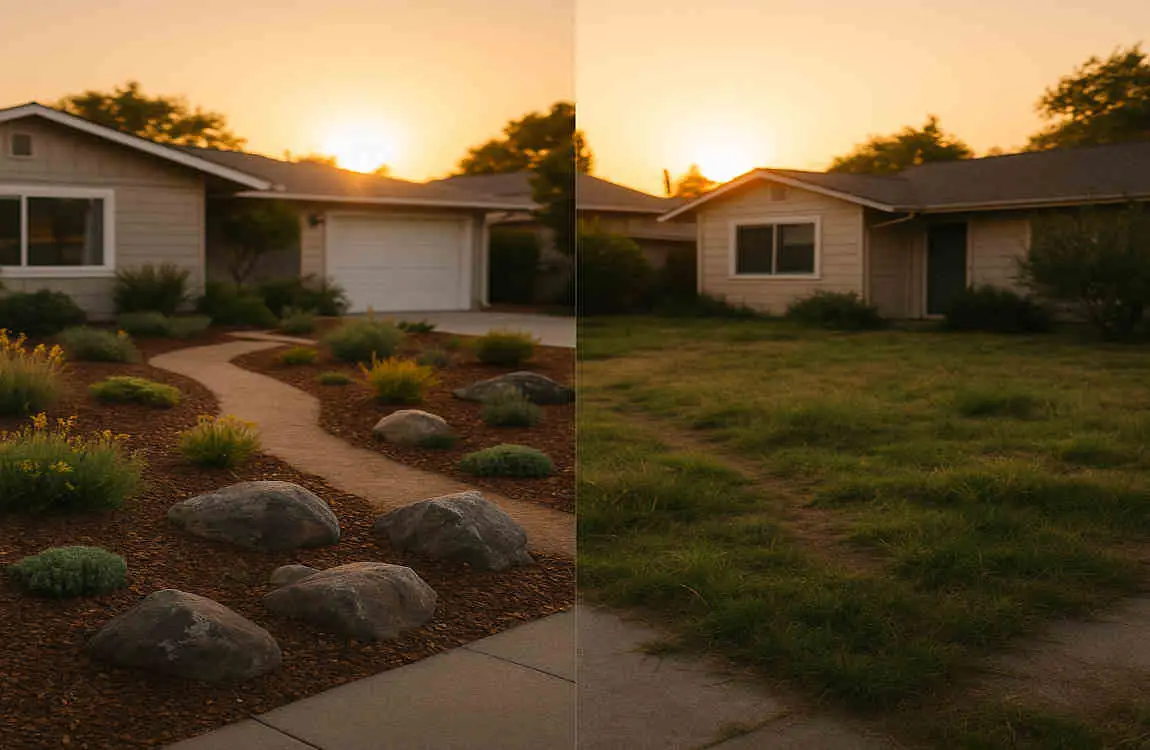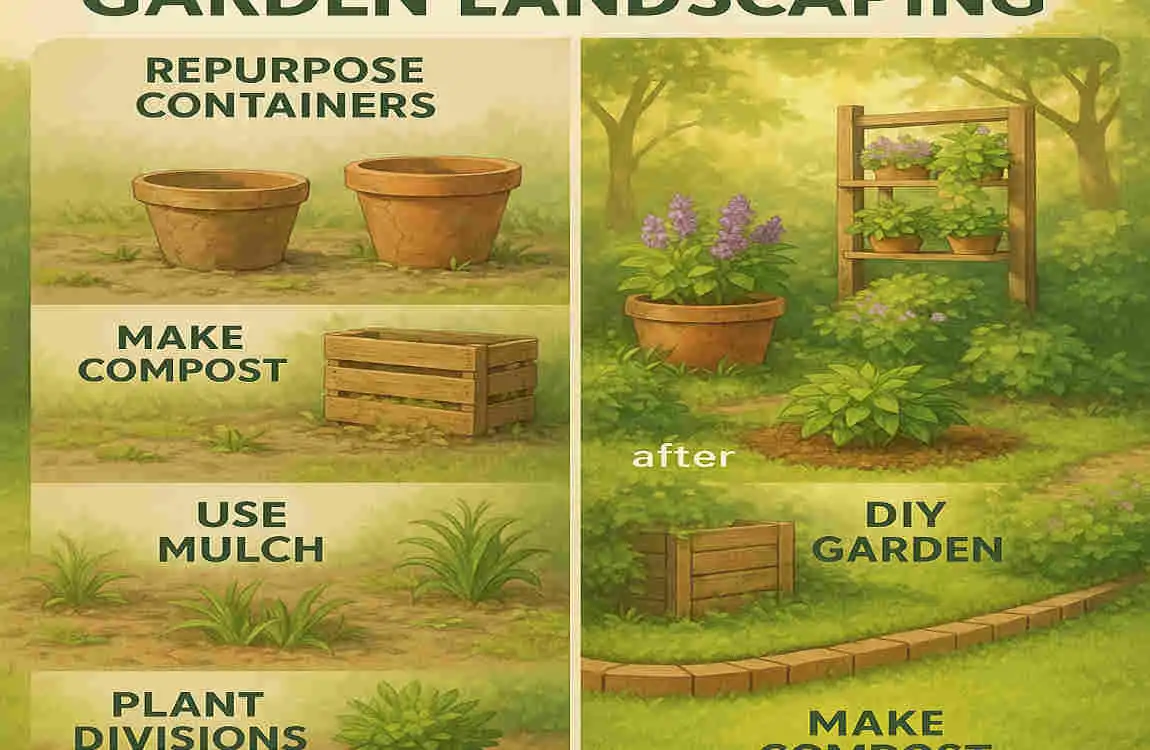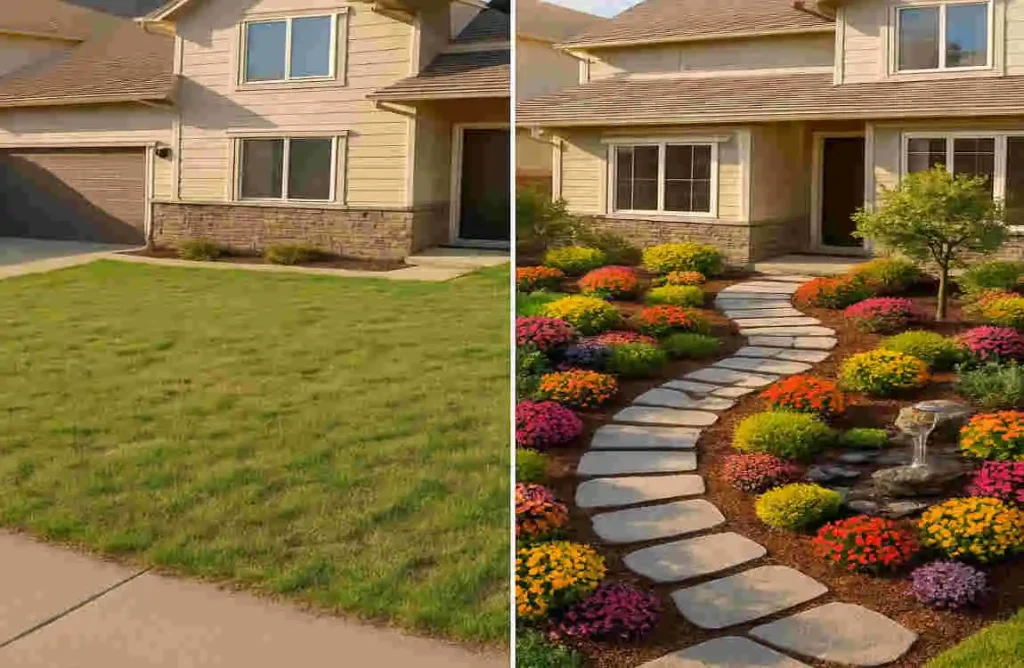Have you ever looked at your outdoor space and wished it could be more inviting, more beautiful, or simply more you? You’re not alone. Millions of homeowners dream of creating their perfect garden oasis, but many believe it requires a hefty budget and professional help. Here’s the good news: transforming your outdoor space doesn’t have to drain your bank account or require a degree in landscape architecture.
Whether you’re a homeowner looking to enhance your property’s curb appeal or a renter seeking to make your temporary space feel more like home, simple and affordable garden landscaping ideas can work wonders. The beauty of budget-friendly landscaping lies in its accessibility – anyone can do it, regardless of skill level or financial situation.
Why Simple and Cheap Landscaping Matters

The Hidden Benefits of Budget-Friendly Gardens
When we discuss simple, affordable garden landscaping ideas, we’re not just talking about ways to save money. We’re exploring a philosophy that brings multiple rewards to your life. Let’s dive into why this approach matters more than you might think.
Improved curb appeal stands as one of the most immediate benefits. Your home’s exterior creates the first impression for visitors, potential buyers, and even yourself when you come home each day. A well-maintained, thoughtfully designed garden space can transform an ordinary house into a welcoming haven.
Beyond aesthetics, there’s personal satisfaction in creating something beautiful with your own hands. Every plant you nurture, every pathway you make, and every corner you transform becomes a source of pride. This hands-on approach connects you with your space in ways that hiring professionals can’t match.
Financial and Emotional Returns
Let’s talk numbers for a moment. Landscaping can increase your property value by up to 15%, according to real estate experts. Even simple improvements, such as adding flower beds or creating defined garden borders, can make your property more attractive to potential buyers. The best part? You don’t need to spend thousands to see these returns.
The mental well-being benefits deserve special attention. Gardens offer a sanctuary from daily stress, providing a peaceful retreat where you can unwind and reconnect with nature. Research indicates that spending time in green spaces can reduce anxiety, improve mood, and enhance overall life satisfaction. When you create this space yourself, these benefits multiply.
Debunking Common Misconceptions
Here’s where we need to clear the air: cheap doesn’t mean unattractive or low quality. Some of the most stunning gardens feature repurposed materials, native plants, and creative solutions born from budget constraints. In fact, limitations often spark the most innovative designs.
Many people believe that affordable landscaping looks “cheap” or temporary. This couldn’t be further from the truth. With the right approach, budget-friendly gardens can rival expensive professional designs. The key lies in planning, creativity, and understanding basic design principles.
Planning for Your Budget Garden
Assessing Your Space Like a Pro
You may also read (transform your living room with house stylish wall lights).
Before diving into simple, affordable garden landscaping ideas, you need to understand your canvas. Start by walking around your property with fresh eyes. Take measurements of different areas – you don’t need fancy tools; a basic tape measure or even your stride length will suffice.
Pay attention to light patterns throughout the day. Which areas receive full sun? Where does shade dominate? This information proves crucial when selecting plants later. Notice how water flows during rain – does it pool anywhere? Understanding drainage helps prevent future problems and guides your design choices.
Consider your soil type, too. Is it sandy, clay-heavy, or somewhere in between? A simple squeeze test can reveal a great deal. Grab a handful of moist soil and squeeze it. If it holds its shape but crumbles when poked, you’ve got loamy soil – the gardener’s gold standard. Clay soil remains clumped, while sandy soil does not hold together at all.
Defining Your Garden’s Purpose
Now comes the fun part – dreaming about what you want. But let’s ground those dreams in practical considerations. Do you have children who need a play space? Do pets require secure areas? Perhaps you love entertaining and need room for gatherings.
Think about privacy needs, too. Maybe you want to screen out a neighbor’s window or create a secluded reading nook. Consider how much time you realistically have for maintenance. Be honest with yourself – there’s no shame in wanting a low-maintenance garden that looks great with minimal effort.
Write down your priorities. This list serves as your roadmap, guiding you in making informed decisions when faced with multiple options. Remember, you can always expand and evolve your garden over time.
Creating a Realistic Budget
Budgeting for landscaping doesn’t have to be complicated. Start by determining how much you can comfortably spend without stress. Even $50-100 can make a significant impact when used wisely.
Here’s a simple budgeting framework:
Category Percentage of Budget Examples
Plants 40-50% Seeds, seedlings, perennials
Materials: 30-40% Mulch, stones, soil amendments
Tools 10-15% Basic hand tools, gloves
Decorative 5-10% Solar lights, garden art
Finding bargains becomes an adventure in itself. Check local classifieds for free materials, such as stones, bricks, or wood. Visit garden centers at the end of the season for clearance plants. Join community gardening groups where members often share divisions of perennials.
Don’t forget to repurpose the materials you already have. That old ladder? Perfect for a vertical planter. Broken concrete? Ideal for creating a rustic pathway. This mindset shift – seeing potential in what others discard – forms the foundation of successful budget landscaping.
Essential Tips for Cheap Garden Landscaping

Start Small and Dream Big
The most successful budget gardens begin with one manageable project. Choose a single area – perhaps your front entrance or a corner of the backyard – and focus your energy there. This approach prevents overwhelm and allows you to see immediate results, which motivates continued progress.
Starting small also allows you to learn as you go. You’ll discover which plants thrive in your conditions, what design elements you prefer, and how much maintenance you’re willing to handle. These lessons prove invaluable as you expand to other areas.
The Art of Reuse and Recycling
Creativity trumps cash when it comes to budget landscaping. Look around your property with fresh eyes. Those old bricks from a demolished wall? Perfect for edging flower beds. The wooden pallets behind the garage? Ideal for creating raised beds or vertical gardens.
Visit construction sites (with permission) for discarded materials. Broken tiles make beautiful mosaic stepping stones. Old gutters transform into sleek planters. Even worn-out boots or colanders can become whimsical container gardens.
Buying secondhand opens up a whole new world of possibilities. Estate sales, garage sales, and online marketplaces offer garden tools, pots, and decorative elements at a fraction of retail prices. One person’s unwanted garden statue might be exactly what your space needs.
Shopping Local and Seasonal
Native plants form the backbone of any successful budget garden. These locally adapted species require less water, fertilizer, and pest control than exotic alternatives. Visit local plant swaps, where gardeners share divisions and seeds for free or minimal cost.
Many communities have native plant societies that hold annual sales with incredibly low prices. These events also provide expert advice tailored to your specific region. Building relationships with fellow gardeners creates a network for future plant exchanges.
Timing Your Purchases
Seasonal timing can significantly reduce your gardening costs. Shop for plants in late summer or early fall when nurseries clear their inventory. Spring bulbs are less expensive when purchased in bulk during the summer. Mulch prices often drop in late fall when demand decreases.
Create a garden calendar noting when different items go on sale in your area. Many stores offer loyalty programs with exclusive discounts. Sign up for newsletters from local nurseries to catch flash sales and special promotions.
Building Your Tool Collection Wisely
You don’t need every garden gadget to create beautiful landscapes. Focus on essential tools that serve multiple purposes:
- A sturdy trowel for planting and transplanting
- Pruning shears for shaping plants and harvesting
- A rake for clearing debris and spreading mulch
- Garden gloves to protect your hands
- A watering can or hose with an adjustable nozzle
Buy quality versions of these basics rather than accumulating cheap tools that break quickly. Check thrift stores and garage sales for vintage tools – older models often feature superior construction and need minor cleaning.
DIY Projects: Simple House, Cheap Garden Landscaping Ideas
Creative Garden Borders
Garden borders define spaces and add instant polish to any landscape. The beauty of DIY borders lies in their flexibility – you can create stunning edges using materials that cost little or nothing at all.
Start with recycled bottles for a colorful, eco-friendly border. Collect glass bottles in similar colors (blues and greens work beautifully) and bury them neck-down along the edge of your garden. The sunlight creates a stained-glass effect that changes throughout the day. This technique works especially well for herb gardens or cottage-style flower beds.
Brick borders offer timeless appeal. Search online marketplaces for free or cheap used bricks. Lay them in various patterns – straight lines for formal gardens, curves for a softer look. Here’s a simple installation guide:
- Mark your border line with a string or a garden hose
- Dig a shallow trench about 4 inches deep
- Add a sand base for stability (optional but recommended)
- Place bricks tightly together, tapping with a rubber mallet
- Fill gaps with sand or soil
Natural stone borders create rustic charm. Collect stones from your property or ask permission to gather from vacant lots. Vary the sizes for visual interest. Stack flat stones for a dry-wall effect or partially bury rounded rocks for a more natural appearance.
Low-Cost Pathways
Pathways serve both form and function in your garden design. They guide visitors through your space, protect plants from foot traffic, and add structure to the overall layout. Best of all, creating beautiful pathways doesn’t require expensive materials.
DIY stepping stones offer endless creative possibilities. Mix concrete in a wheelbarrow (one bag costs under $10) and pour into pizza boxes, old cake pans, or plastic plant saucers. Press decorative elements, such as marbles, shells, or handprints, into the concrete before it sets. Space these personalized stones through your lawn or garden beds.
Pallet pathways provide instant rustic appeal. Disassemble wooden pallets and use the planks to create boardwalk-style paths. This works especially well in shady areas where grass struggles to grow. Treat the wood with linseed oil for added longevity, or allow it to weather naturally for a silver-gray patina.
Mulch walkways rank among the most affordable options. A thick layer of wood chips or shredded bark creates comfortable, natural-looking paths, edged with logs or stones to keep mulch contained. Refresh annually by adding a thin top layer – the bottom decomposes, enriching the surrounding soil.
Gravel paths offer durability and drainage. Pea gravel or crushed stone may cost more initially, but it lasts for years. Lay landscape fabric first to prevent weeds, then add 2-3 inches of gravel. The satisfying crunch underfoot adds sensory appeal to your garden experience.
Upcycled Planters & Pots
Container gardening opens possibilities for renters and homeowners alike. Instead of buying expensive planters, transform everyday items into unique growing spaces that showcase your personality.
Tin cans become charming herb gardens with minimal effort. Remove labels, drill drainage holes, and paint with outdoor paint or leave it plain for an industrial chic look. Group different sizes together for visual impact. Attach to fence posts or walls using simple brackets for vertical growing.
Old furniture finds new life as planters. That broken dresser? Each drawer becomes a planting box. A worn-out chair? Remove the seat and insert a pot. Vintage colanders, enamel pots, and metal buckets already have drainage and need to be filled with potting mix.
Tire planters work wonderfully for larger plants. Paint them bright colors or leave them black for a modern look. Stack different sizes for a tiered effect. Turn them inside out for a smoother appearance. Fill with good soil and plant a variety of flowers and vegetables.
Vertical gardening maximizes space using walls and fences. Create a living wall with:
- Shoe organizers hung on fences (perfect for herbs)
- Gutters mounted horizontally as narrow planters
- Pallets leaned against walls with landscape fabric backing
- Repurposed ladders with planks across rungs for shelf space
Easy Water Features
Water adds life and movement to any garden. The gentle sound masks traffic noise and attracts beneficial wildlife. Creating water features doesn’t require pumps, electricity, or major expense.
Mini ponds bring aquatic beauty to small spaces. Use a large plastic tub, an old sink, or a half whiskey barrel. Here’s how:
- Choose your container and location (partial shade works best)
- Add rocks or bricks for varying depths
- Fill with water and let sit for 24 hours to release chlorine
- Add aquatic plants like water lilies or floating plants
- Include mosquito dunks to prevent breeding
DIY bird baths attract feathered friends while adding focal points. Stack terra cotta pots and saucers in decreasing sizes, securing with construction adhesive. Use large plant saucers on decorative stands. Even an upturned trash can lid on a tree stump works beautifully.
Solar fountains provide movement without electrical costs. Small solar pumps cost under $20 and transform any water container into a fountain. The gentle bubbling attracts birds and creates a soothing ambiance.
Functional Lighting Solutions
Garden lighting extends enjoyment into evening hours while adding safety and ambiance. Solar technology makes lighting affordable and installation simple – no electrician needed.
Solar stake lights line pathways effectively. Buy in bulk for better prices. Mix heights for visual interest—clean solar panels regularly for maximum efficiency. In shady areas, consider models with separate panels that can be positioned in sunnier spots.
Mason jar lights create a magical ambiance. Wrap wire around jar rims to make hangers. Insert solar lid lights (available online) or battery-operated LED strings. Hang from shepherd’s hooks, tree branches, or along fence lines.
Repurposed fixtures add character. Old chandeliers become garden art with battery-operated candles. Vintage lanterns house solar lights beautifully. Even tin cans with punched patterns cast interesting shadows when lit from within.
Raised Garden Beds
Raised beds solve multiple garden challenges – poor soil, drainage issues, and accessibility concerns. Building them yourself saves hundreds of dollars compared to purchasing kits.
Pallet beds offer instant gratification. Stand pallets on edge and secure corners with screws or wire. Line with landscape fabric, fill with soil, and plant. One pallet creates a 4×4-foot growing space, perfect for vegetables or cutting flowers.
Scrap wood construction lets you customize sizes. Use untreated lumber (avoid pressure-treated near edibles) to create simple boxes:
- Cut boards to desired lengths
- Screw corners together with deck screws
- Add corner braces for extra stability
- Line the bottom with hardware cloth to deter burrowing pests
- Fill with quality soil mix
Straw bale gardens provide temporary raised beds that decompose into rich compost. Condition bales with water and nitrogen for two weeks, then plant directly into the bales. Perfect for renters or testing garden locations.
Edible Herb Spiral Gardens
Herb spirals maximize growing space while creating stunning focal points. This permaculture technique creates various microclimates in minimal space, making it perfect for herbs with different needs.
Building a spiral requires only basic materials:
- Stones or bricks for the structure
- Cardboard for weed suppression
- Quality soil and compost
- Herb plants or seeds
Start by marking a circle about 5-6 feet in diameter—lay cardboard to kill grass. Begin stacking stones in a spiral pattern, gradually increasing height toward the center (aim for 3-4 feet). Fill with soil as you build.
Plant placement follows each herb’s needs:
- Top center: Mediterranean herbs (rosemary, thyme, oregano) that prefer dry conditions
- Middle sections: Moderate-water herbs (basil, cilantro, parsley)
- Bottom edges: Moisture-loving herbs (mint, chives, watercress)
You may also read (essential tips for maintaining wooden outdoor furniture).
The spiral design creates natural irrigation, allowing water to flow from top to bottom. Add mulch between plants to retain moisture and suppress weeds.
Cozy Outdoor Seating and Nooks
Every garden needs places to pause and enjoy the fruits of your labor. Creating comfortable seating doesn’t require expensive outdoor furniture.
Log benches offer rustic simplicity. Find a fallen tree (with permission) and cut it to the desired length. Support with smaller log sections or stone pillars. Sand smooth and apply linseed oil for weather protection. These natural seats age beautifully and blend seamlessly with their surrounding gardens.
Repurposed chairs add whimsy and comfort. Old dining chairs are transformed into weather-resistant garden seating with a fresh coat of paint. Remove torn seats and replace them with weather-resistant fabric or create living seats by planting succulents in the frame.
Pallet furniture provides endless possibilities—stack pallets for instant coffee tables. Add cushions to create sofas. Stand pallets vertically as privacy screens with built-in planting pockets.
Creating intimate spaces transforms gardens into outdoor rooms:
- Use tall plants or trellises for privacy walls
- Add overhead elements like tree canopies or fabric sails
- Include soft elements – cushions, outdoor rugs, throws
- Position near fragrant plants for sensory enjoyment
Using Native and Low-Maintenance Plants
The Power of Going Native
Native plants form the foundation of sustainable, budget-friendly gardens. These locally adapted species evolved alongside your region’s climate, soil, and wildlife. They require minimal intervention once established, saving you time, money, and resources.
Research your plant hardiness zone and native species. Local extension offices provide free lists tailored to your exact area. Native plant societies offer workshops and plant sales that include expert guidance and advice.
The benefits multiply quickly:
- Reduced water needs after establishment
- Natural pest resistance (they evolved with local insects)
- Wildlife support for birds, butterflies, and pollinators
- Year-round interest in species for every season
- Minimal fertilizer requirements
Budget-Friendly Plant Superstars
Some plants deliver maximum impact for minimum investment. These reliable performers excel in diverse conditions, providing long-lasting beauty.
Perennials that keep giving:
- Spirea: Clusters of flowers, attractive foliage, incredibly hardy
- Salvia: Long-blooming, drought-tolerant, loved by hummingbirds
- Black-eyed Susans: Cheerful flowers, self-sowing, native to many regions
- Ornamental grasses: Movement, texture, winter interest
- Sedum: Succulent flowers, attracts butterflies, thrives on neglect
Self-sowing annuals provide free plants year after year:
- Cosmos: Delicate flowers all summer
- Zinnias: Bold colors, cut flower excellence
- Marigolds: Pest deterrent properties
- Sunflowers: Quick growth, wildlife food source
Strategic Plant Combinations
Mixing annuals and perennials creates dynamic displays while managing costs. Perennials provide permanent structure. Annuals fill gaps with seasonal color. This combination enables experimentation without incurring significant investment.
Succession planting ensures continuous blooms. Choose plants with staggered flowering times. Spring bulbs give way to summer perennials, followed by fall-blooming asters. This approach maximizes visual impact throughout the growing season.
Groundcovers reduce maintenance while adding beauty. Instead of struggling with grass in difficult areas, plant spreading perennials:
- Creeping phlox for sunny slopes
- Ajuga for shady areas
- Creeping thyme between stepping stones
- Wild strawberries for edible groundcover
Maximizing Small Spaces & Curb Appeal
Vertical Gardening Solutions
When ground space is limited, look up. Vertical gardening techniques transform blank walls and fences into productive, beautiful spaces.
Living walls don’t require expensive systems. Create your own with:
- Pocket planters made from felt or recycled materials
- Trellis systems for climbing plants
- Hanging gutters arranged in tiers
- Wire mesh with pots attached via hooks
Climbing plants provide maximum coverage with minimal footprint. Annual vines, such as morning glories and nasturtiums, grow quickly from seed. Perennial climbers, such as clematis and honeysuckle, provide years of beauty.
Small Space Design Principles
Creating an illusion of space involves clever design tricks that cost nothing but thought:
Use diagonal lines in pathways and bed edges. This draws the eye across the longest dimension, making spaces feel larger. Avoid straight paths that lead directly to boundaries.
Layer plants by height with the tallest in the back, the shortest in the front. This creates depth and allows every plant to shine. Include plants with fine textures in the background – they appear to recede into the distance, creating a sense of depth.
Mirrors multiply garden views. Position weather-resistant mirrors to reflect attractive plantings. Even old window frames with mirrors backing create architectural interest while expanding visual space.
Enhancing Curb Appeal on a Budget
First impressions matter, and your front yard creates them. Focus efforts here for maximum impact.
Frame your entrance with matching planters or symmetrical plantings. This creates a welcoming pathway that guides visitors to your door. Use repetition of colors or plant types for cohesion.
Define bed edges clearly. Crisp edges between lawn and planting beds instantly elevate your landscape’s appearance. A sharp spade and 30 minutes of edging work wonders.
Add vertical elements near the entrance. A small trellis with climbing roses, a tuteur with annual vines, or even a shepherd’s hook with hanging baskets draws the eye upward and adds sophistication.
Mailbox gardens offer prime real estate for curb appeal. Plant low-growing perennials that won’t obstruct mail delivery. Add spring bulbs for early color. Include evergreens for year-round structure.
You may also read (how can i build a pallet bar house with a roof).

